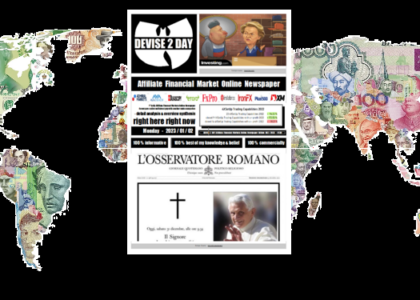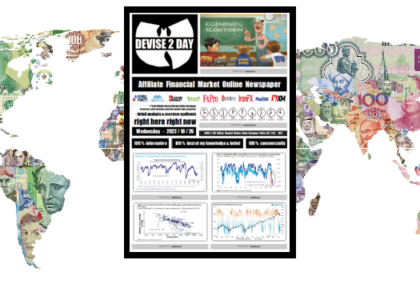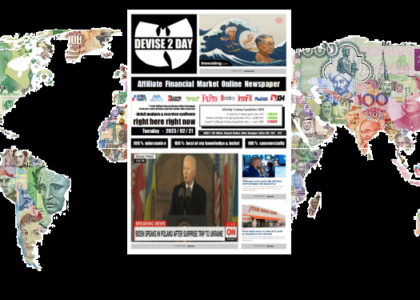
2023/02/27 (179) Column
The financial Market Participant
In Times Without Growth!
What To Do?
“Equities will have a hard time generating above-average returns,” writes BNP Paribas.
This also applies if the companies’ still optimistic profit expectations are more in line with economic reality. They are particularly cautious with European stocks, but the experts are more optimistic about US growth stocks and Chinese A-shares. Even if an appreciation is currently unlikely, valuations appear attractive. That speaks for a strategic positioning. “Opportunities arise, for example, because Chinese consumers are placing increasing value on quality and want to improve their standard of living, but also in the expansion of the deep-tech industry, which drives technological innovations,” says BNP Paribas.
The economic outlook for 2023 for the major French bank BNP Paribas is rather pessimistic.
The global economy is sliding into a recession, they wrote. The analysts see the reasons for this, among other things, in the key interest rates, which are skyrocketing, the energy shock in Europe and the weakening real estate markets. The experts are particularly concerned about the West, where state aid for private households and companies is undermining central bank policy and its anti-inflationary measures. Which, in the analysis, I don’t want to contradict – but as far as the assessment on the financial market is concerned, a little bit. Because I still assume that we experienced the peak of US inflation in the summer of 2022. And or 1 to 2 months later the low in the US stock markets. But as far as the high in US yields in autumn 2022 is concerned, I am no longer sure today. And I also closed our long 4XSetUp Trading Capability in the DOW Future based on this new expectation, i.e. hypothesis. In the DAX Future, the 15,000 price action mark is the decisive front line for me – over 15,000 long in the DAX Future. And that until the market, i.e. the remaining financial market participants, have (not) read the riot act to me. So have taught a better one. Therefore, based on this knowledge, also based on this hypothesis (I find this description most appropriate), I have also formulated all our currently open 4XSetUp Trading Capabilities the way I have formulated…
DEVISE 2 DAY 48h
– Last News About What Drives The News Media
Kremlin chief Vladimir Putin has described Western arms sales to Russia-invaded Ukraine as “participation in crimes” in the country. NATO members would supply Kiev with weapons worth billions of dollars, Putin told state television on Sunday. These deliveries are “in a way” a participation in the war, because Kiev receives the weapons without payment. The West is thus “partly to blame for the shelling of residential areas,” Putin claimed. Western politicians have repeatedly rejected this view.
A year after the start of the Russian attack on Ukraine, Putin again portrayed “leading NATO countries” as aggressors. “They have only one goal – the dissolution of the former Soviet Union and its most important part, the Russian Federation,” said the president. The 70-year-old emphasized that the most important thing for a Russian victory was “the unity of the people”.
DEVISE 2 DAY Another 48h
– Last News About How Drives The Price Action
Futures are trending friendly premarket, with an overall mixed picture. The US dollar is trending slightly weaker while 10-year Treasury yields are slightly higher. After hitting tech and mega-tech stocks in particular last week, we see a countermovement in these areas in particular. As for the S&P 500, today we see a bounce off the 200-day moving average, which stands at 3966 points. To get a sustainable rally on the equity side, we need a retracement in US Treasury yields. Technically, the rise in yields is grossly overblown and emotion-driven, with a reversal imminent very likely. The fact that the PCE price index was too high in January should not have come as a surprise after consumer and producer prices.Forex
GBPUSD Rises
DXY Falls From 7-Week
EURUSD Approaches At 1.06
USDJPY Bottoms At 2-Month Low
10Y Bond Yields
German 10-Year Bond Yield Tops 2011-Highs
Japan 10-Year Bond Yield Remains at YCC Threshold
Commodities
Rice at Over 2-Month Low
Silver Drops to 4-Month Low
Wheat Slides to 17-Month Low
Stock Markets
China Stocks Fall on Weak Global Sentiment
Sensex Falls to Over 4-Month Low
Russian Shares Start Week Sharply Higher
European Stocks Start Week Higher
FTSE 100 Snaps Four-Day Decline
Wall Street Starts Week on Positive Note
Forex
Sterling Rises on Windsor Framework
DXY Falls from 7-Week High
Euro Approaches At 1.06
Japanese Yen Bottoms At 2-Month Low
Sterling Rises on Windsor Framework
The British pound strengthened almost 1% to $1.2035, up from a 7-week low touched below $1.2, after British Prime Minister Rishi Sunak signed a new trade deal with the European Union to tackle issues with the Northern Ireland Protocol. The new agreement, known as the Windsor Framework, includes safeguarding trade flows within the UK, protecting Northern Ireland’s place within the UK, and giving the region’s assembly in Stormont say over new EU rules with the introduction of a “Stormont brake.” On the monetary policy front, the Bank of England is seen increasing Bank Rate by a further 25 bps to 4.25% next month to combat double-digit inflation, before ending the current tightening cycle that sent borrowing costs to the highest levels since late 2008.
DXY Falls from 7-Week High
The dollar index extended losses to 104.9, down from a seven-week high hit above 105 as investors digest the latest economic data and try to gauge the next monetary policy steps. Hotter-than-expected economic data raised the prospect of interest rates staying higher for longer as the Federal Reserve fights stubborn inflation. Investors have now priced at least three more 25 basis point rate hikes this year and see interest rates peaking at around 5.5% by June. Market participants now look ahead to more US economic reports, such as consumer confidence, the ISM manufacturing survey, and corporate earnings. Meanwhile, durable goods orders fell more than expected in January.
Euro Approaches $1.06 as Investors Reposition for Further Rate Hikes
The euro approached $1.06 in the last days of February but remained close to low levels of January 5th as investors repositioned for further interest rate increases from both the ECB and the Fed. Traders expect the European Central Bank to raise key rates by another 50bps in March, while the peak rate for the deposit facility is projected to reach 3.9% in February 2024. Fresh inflation data due this week should provide further clarity on inflationary pressures in the Eurozone, with the core rate seen steady at a historical 5.3%.
Japanese Yen Bottoms at 2-Month Low
The Japanese yen weakened past 136 per USD in late February, hovering at its lowest in over two months as Bank of Japan Governor nominee Ueda doubled down on the importance of the bank’s ultra-easy monetary policy stance. In a second parliamentary hearing for the cargo’s confirmation process, Ueda stated that the benefits from the BoJ’s stimulus outweigh the negative side effects for the current economic scenario, adding that a shift to tighter policy would only be necessary should inflation increase significantly. The remarks reinforced signals that the bank would not pivot from its dovish stance soon.
10Y Bond Yields
German 10-Year Bond Yield Tops 2011-Highs
Japan 10-Year Bond Yield Remains at YCC Threshold
German 10-Year Bond Yield Tops 2011-Highs
Germany’s 10-year bond yield rose to 2.57% in late February, the highest since July 2011, amid increasing bets the ECB will continue to raise interest rates beyond 2023. The peak rate for the benchmark deposit facility is now seen at 3.9% in February 2024, compared to 3.5% in July 2023, projected a few weeks ago. Preliminary February inflation data for Euro Area due this week will be keenly watched, especially the core rate, which is expected to hold at a record high of 5.3%. Meanwhile, ECB President Lagarde has recently told India’s Economic Times that “there is every reason to believe that we will do another 50 basis points in March” and the central bank “will do more hikes if necessary to return inflation to our target of 2% in a timely manner”.
Japan 10-Year Bond Yield Remains at YCC Threshold
The yield on the 10-year JGB consolidated slightly above 0.5% in late February, testing the limit imposed by the Bank of Japan’s yield curve control as the bank’s Governor nominee Ueda outlined possible monetary policy paths. While stressing the need for loose monetary policy in the current economic environment, Ueda agreed there were various side effects from the central bank’s yield curve control, suggesting a forthcoming pivot. Inflation in Japan rose to 4.3% in February, its highest since 1981. Meanwhile, the core index climbed to a 41-year record, remaining above the BoJ’s target for the ninth month, largely due to more expensive commodity imports. Still, Ueda warned against immediate tightening, opposing any haste to transition away from the ultra-low policy stance and saying that responding to cost-driven inflation would hamper economic activity. The BoJ has purchased JGBs in massive amounts to preserve the ceiling on the 10-year bond, keeping borrowing costs low.
Commodities
Rice at Over 2-Month Low
Silver Drops to 4-Month Low
Wheat Slides to 17-Month Low
Rice at Over 2-Month Low
Rice futures were trading around $16.8 per hundredweight, their lowest since December 15th, amid expectations of ample supplies despite rising demand. The Commerce Ministry said Thailand’s rice exports for January were at 805,519 tonnes, up 75.2% from a year earlier, helped by year-end orders, higher demand from the Middle East, and a weak baht currency. In the meantime, the USDA’s latest outlook report indicated that the 2022/23 production forecast remained at 503.0 million tons, around 2% down from 2021/22. Upward production revisions for Bangladesh, Sri Lanka, Thailand, and Uzbekistan were offset by reductions for Argentina, Brazil, Cuba, the European Union, and Vietnam. Global consumption grew by 1.1 million tons to 517.2 million, with Bangladesh, China, and Thailand accounting for the bulk of the revision.
Silver Drops to 4-Month Low
Silver futures sank below $20.6 per ounce at the end of February, risking to close the month 14% lower at their weakest level in four months, as expectations of higher interest rates continued to pressure bullion demand. Hotter-than-expected PCE prices and spending data in the United States added to the signs of the overheating American economy, strengthening the FOMC’s concerns that inflation risks are on the upside and further hikes will be needed. Despite raising the opportunity cost of holding non-interest-bearing bullion assets, tighter policy hampered demand for the metal as an industrial input for goods with high electricity conduction needs, which was mainly reflected in the aggressive declines in solar panel equities. Still, low stockpiles of main commodity exchanges limited the decline for silver.
Wheat Slides to 17-Month Low
Wheat futures in the US retreated sharply to below the $7.2 per bushel mark in late February, the lowest in 17 months, amid expectations of abundant supplies from the world’s leading exporters in the near term. According to President Putin’s speech to the country’s Federal Assembly, top exporter Russia is projected to sell up to 60 million tonnes of wheat in foreign markets in the current marketing year. Russia harvested a record-high 153.8 million tonnes of wheat in 2022, driving farmers to turn to international customers to empty silos ahead of the new harvest. Additionally, hopes for the extension of Ukraine’s deal on shipping wheat out of Black Sea ports magnified forecasts of ample supplies. On top of that, the Indian government released 5 million tonnes of wheat from government stocks in 2023 to combat soaring food inflation in the country.
Stock Markets
China Stocks Fall on Weak Global Sentiment
Sensex Falls to Over 4-Month LowRussian Shares Start Week Sharply Higher
European Stocks Start Week Higher
FTSE 100 Snaps Four-Day Decline
Wall Street Starts Week on Positive Note
China Stocks Fall on Weak Global Sentiment
The Shanghai Composite fell 0.28% to close at 3,258 while the Shenzhen Component lost 0.73% to 11,702 on Monday, with Chinese stocks sliding for the fourth straight session as hotter-than-expected US inflation data bolstered expectations that the Federal Reserve will need to continue raising interest rates. Investors also continued to monitor developments amid rising geopolitical tensions between China and the US, while awaiting manufacturing and services activity data in China later this week. Technology and new energy stocks led the decline, with notable losses from Inspur Electronic (-2.5%), 360 Security Technology (-8.1%), Luxshare Precision (-3.2%), BYD Company (-2.9%) and Contemporary Amperex (-0.9%).
Sensex Falls to Over 4-Month Low
The BSE Sensex dropped 447.5 points or 0.8% to an over four-month low of 58,992.4 in morning trade on Monday, falling for the seventh session and tracking a decline in Asian markets, pressured by a sharp pullback on Wall Street Friday with prospects of more tightening by the Fed growing after PCE index rose more than expected in January. A rising of the US 10-year Treasury bond yield to 3.93% also weighed on sentiment. Traders cautiously awaited India’s GDP growth data for Q4 of 2022 which is due on Tuesday. Reuters forecast the country’s economy to expand at 4.6%, much softer than a 6.3% expansion in Q3, amid weakening demand following a series of interest rate hikes by the RBI to curb inflation. Almost sectors were trading in the red, with media, metals, auto, technologies, and pharmaceuticals among bottom movers. Shares of MPhasis plunged by 7.3%, followed by Jindal Stainless Ltd (-6.3%), Zee Entertainment Enterprises Ltd (-6.1%), Adani Enterprises (-5.4%), and NDTV (-4.8%).
Russian Shares Start Week Sharply Higher
The MOEX Russia index closed 1.5% higher at 2,240 on Monday, nearly paring losses from the prior week as investors reassumed positions that were sold on Friday to avoid geopolitical escalation over the weekend, as world leaders continued to discuss measures against Russia after its invasion of Ukraine completedone year of duration. Oil producers booked sharp gains ahead of Russia’s planned cut in oil exports in March. Supply of oil to Europe was also seen lower after Russia halted flows to Poland through the Druzhba pipeline. Metallurgists and miners also closed sharply higher, with Kommersant stating that Chinese imports of coal have quintupled year-to-date.
European Stocks Start Week Higher
European equity markets rose on Monday, after booking their worst weekly performance this year, with the DAX and the STOXX 600 adding 1.1% each. Travel and leisure stocks led gains in the Old Continent, rising more than 2%. Among single stocks, Commerzbank advanced almost 5%, as investors cheered the come back of its shares to Germany’s blue-chip DAX index on Monday. On the data front, confidence indicators for the Eurozone were mixed in February, with sentiment improving among traders, consumers and constructors but weakening among manufacturers and service providers. Elsewhere, British Prime Minister Rishi Sunak signed a new trade deal with the European Union to tackle issues with the Northern Ireland Protocol.
FTSE 100 Snaps Four-Day Decline
Equities in London snapped four sessions of losses on Friday, with the benchmark FTSE 100 bouncing back to close around 7,770 points, driven by gains in consumer discretionary, energy, and technology stocks. Investors welcomed headlines that the UK and the EU secured a new post-Brexit deal for Northern Ireland in a move set to end long-running tensions following the UK’s withdrawal.
Wall Street Starts Week on Positive Note
The Dow closed 72 points higher on Monday, while the S&P 500 and Nasdaq 100 added 0.3% and 0.6%, respectively, after the worst weekly selloff of the year as investors digested new economic data and reassessed the outlook for monetary policy. The US Census Bureau reported that durable goods orders fell more than expected in January as consumers pulled back spending on big-ticket items. Last week, hotter-than-expected economic data raised the prospect of interest rates staying higher for longer as the Federal Reserve fights stubborn inflation. Investors have now priced at least three more 25 basis point rate hikes this year and see interest rates peaking at around 5.5% by June. On the corporate side, Union Pacific shares jumped 9.3% after the company announced that its CEO would step down in 2023. Shares of Tesla 5.4% after Reuters reported that the electric vehicle maker hit a production rate of 4,000 vehicles per week ahead of schedule.DEVISE 2 DAY 48h
– Where I Was Wrong, Where I Was Right
The Market is under pressure since two, three weeks!
The Market? Yes, the US WallStreet, in New York – the stock market.
But not the US Yield Curve, in Chicago, which is more expensive than years; than decades! At that is the crucial point; why the stock market is breathing out; last days, last weeks.
However,
we stay long in EURUSD, long in the DAX Future, and/or also (since the beginning of last week before) now long in the ADIDAS share & BITCOIN. And since last thursday, even last week, we`re back short in UKOIL also.
Nevertheless it itches me again to formulate a new 4XSetUp in the DOW Future. And that because i don`t realize a bullisg technical chart, right now. That`s why i will write a new long Technical Analysis 4XSetUp only if at least the technical picture looks bullish again. Because currently, at least in my personal subjective individual opinion, it still looks rather bearish in the short term. And that just before the upcoming US labor market data next week and/or much more the US inflationnumbers in the calendar week after next week. So I prefer to wait a little longer. Because going anti-cyclically long in the DOW Future, let alone in the NASDAQ Future, only because of the hope of worse than expected US labor market figures and/or lower than expected inflation numbers, is too speculative for me. That`s why the motto for this week, in relation to the DOW chart, is observe, analyze, and/or evaluate. And if you dare, you can get long in the DOW Future this week again. But at least I want to have a weekly candle in the plus in my back to go long again. That’s the minimum; even if it smells and/or tastes old school…
good morning, good day, and/or good night
at whatever time, wherever you are !
right here right now :


















